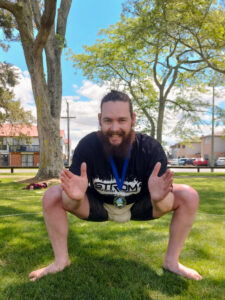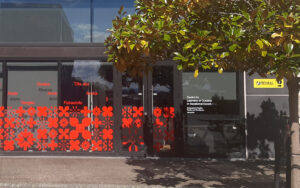Ambulance volunteer ready and waiting
Amy Tapp never knows what her next challenge will be while she waits for the pager to sound at St John’s Ngaruawahia headquarters.
It is a cold and foggy Monday night and in Ngaruawahia it appears not a single soul is out walking the streets. An eerie silence suggests the town has been deserted. The dim light smothered by curtains in the houses and the breath of smoke from the chimneys are the only signs of life.
But somebody will need help tonight. Perhaps the fog becomes blinding for someone returning home, or maybe medical help is required. Whatever the case, the St John Ambulance team is waiting.
St John volunteer Amy Tapp, 20, is on a 12-hour shift and sits in the Ngaruawahia headquarters reading her book. Her work partner, ambulance officer for Otorohanga Maggie Hughes, knits baby clothes and watches the television. Both are waiting at the ready for their pagers to beep, or for the MDT computer screen in the ambulance to go off, telling them they have a job to go to.
Amy, who has been volunteering for five months, balances her time at St John with studying nursing at Wintec and her paid work as a florist at New World Supermarket in Te Rapa.

She enjoys the quick-paced atmosphere of emergency and runs through the checklist of what to do when starting a shift.
“When the two officers arrive for their shift, we need to do a ‘full truck check’ and report any faults in the ambulance. We check all the medical supplies, the gases and all the equipment in the life pack to make sure it works and it has enough battery.”
Once supplies have been checked and the lights and sirens have been tested to make sure they work, the officers go to the headquarters’ lounge and wait for a job.
“When we get a job, the MDT computer touch screen in the ambulance will sound and so will our pagers. When we are in the ambulance, the screen comes up with the priority, the code for the job, the address of where we’re going, and the time and date we were alerted,” Amy explains.
“Each person will be given a priority code, depending on their state of health when we arrive on the scene. For example, if someone is given a code of one or two they will be in a critical condition. Four or five is less serious, and we give the priority zero to someone who has passed away. It’s good to know the priority before going to a job because then you can prepare yourself.”
Rewarding challenges
Amy, who is originally from Ngaruawahia, had an interest in ambulance work from an early age. It was not until one of the team managers from St John in Ngaruawahia bought flowers from her that she had the chance to become involved.
“My manager came in to buy flowers and we got talking. I said, ’I really want to do this. I just don’t know how to go about it.’ And she replied, ’Well we’re actually looking for new people to volunteer out in Ngaruawahia.’ It was actually really weird how much of a perfect fit it was.”
Few people of Amy’s age are faced with the challenges she and other St John ambulance officers have to deal with. But just like any emergency worker, she insists it is more rewarding than anything.
“Everyone gets sick at some point in their life and people do need a hand once in a while. Someone will always be there with St John.”
[pullquote]It’s not something I always wanted to do. It took me a while but once you get hooked, you’re hooked.”[/pullquote]
Being based at Ngaruawahia doesn’t mean just attending callouts in that area.
“Seventy per cent of our jobs are in Hamilton and we cover Huntly, Morrinsville and Raglan as well,” Amy says.
She has been though courses ranging from basic first aid to manual handling, to become an observer. This means she can volunteer and observe situations with another experienced officer. Because still fairly new, Amy is yet to complete all the courses, including the driving course. A senior officer is always with Amy, to monitor her until she reaches a higher qualification.
The levels of qualifications range from observer, first aider, ambulance officer or emergency medical technician (EMT), to paramedic and advanced paramedic. Becoming an ambulance officer gives the opportunity to be paid.
Amy is motivated to climb the ladder.
“It depends on what stage in my life I’m at and if I like it when I get to that stage but hopefully I can work my way right to the very top,” she says
“I like thinking on my feet which is why emergency work appeals to me. I can definitely see myself doing this as a career. I’ll be here for a while.”
Seventeen-year veteran
For her shift partner, ambulance officer Maggie Hughes, the ability to help others is rewarding but it took time to become captivated by the tough work of a paramedic.
“It’s not something I always wanted to do. It took me a while but once you get hooked, you’re hooked.”
Maggie has been involved in ambulance work for 17 years and is based in Otorohanga, where she also works part-time at the Kiwi House. She has been relieving at the Ngaruawahia station for a few days.
Maggie was first introduced to the idea of being a paramedic when she was filling her car at a petrol station. She met a woman she knew, who worked at St John and said they were in desperate need of ambulance officers.
“I was unemployed at the time and she said, ’Maggie you’d make a good ambulance officer.’ I replied ’No, I wouldn’t be able to handle it – I can’t stand people who vomit.’ ’Neither can I!’ she replied so I went out there that night to see what it was all about.”
Maggie has seen many changes in the 17 years she has worked with St John.
“There are more binge-drinking and drug-related callouts now than there was 17 years ago. That’s a sad indication of how society’s evolving.”
She has also witnessed changes to how the ambulance team operates.
“When I first joined we weren’t allowed to do anything. All we ever did was give people oxygen and now we do much more because we’ve been taught the skills and we are learning all the time,” she says.
“Local doctors aren’t as accessible now so as officers we have more responsibility.”
Both Maggie and Amy not only attend to people in critical conditions, but also have to console those who have just witnessed their loved ones being burnt, bloodied or broken.
“One night I had to sit for hours with a family whose son was being air-lifted to hospital. I just sat with them and had lots of cups of tea,” says Maggie.
She enjoys the team of officers she works with. Once a fortnight they will all get together socially, along with the local firefighters and participate in games like darts or tenpin bowling.
“It’s the same with us here in Ngaruawahia,” Amy adds.
“We are all so close. We get together every fortnight too, with the fire officers as well. We play games like ‘are you smarter than a fire fighter?’ Sadly they beat us but at least we got all the medical questions right!”
The ambulance officers and firefighters need this strong relationship to get through the tough jobs they face.
“Every ambulance officer has to go through at least three ‘major jobs’ and they will stick in your head like it happened yesterday,” says Maggie.
There is peer support, counselling and psychiatrists offered to all ambulance officers, but sometimes, as Maggie found, the best remedy is just talking to one another.
“One of my colleagues was faced with a tough job and he would just come over to my house every night and we would talk over a cup of tea.”
However tough it gets, neither woman would think of giving up.
“It’s so interesting, no two jobs are ever the same and it makes everything worth while knowing you’re always helping someone,” Maggie says.




